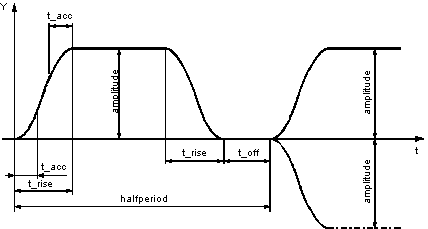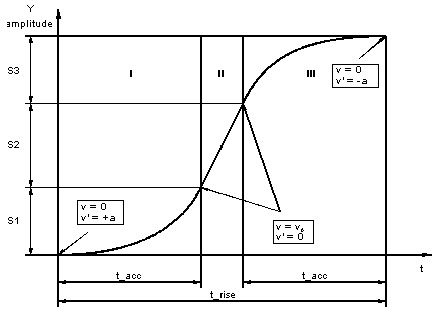The function is defined completely in the data structure
Para_FGEN. First of all the waveform must be determined (refer to
Function selection).
Trapezoid (Delta, Saw-tooth, Square) unipolar/bipolar is selected as the basic type for the definition.
Function amplitude is determined in the parameter amplitude. It should be noted that this declaration applies to unipolar operation. Amplitude in bipolar operation is doubled and consists of amplitude and -amplitude.
The parameter halfperiod defines the half cycle duration.
Parameter t_off defines an idle time. A half cycle of the function is then output within the time halfperiod - t_off.
For the trapezoid function definition the rise time t_rise is also required. This is the time in which the signal should accelerate from 0 to amplitude. This time is also taken for the descent from amplitude back to 0.
If a function in ramp form is to rise or decline, the transitions are first of all always made in a sharp crease. The gradient is not constant in this case. "Smoothing" is used to achieve a soft rise and descent, i.e. the ramp turns into an S-curve.
"Smoothing" a function
This is then divided into three sections. Section I "accelerates" directly from 0. Section II is traversed with the velocity attained at the end of section I. In section III, the acceleration from section I is used to brake, and thus approach the terminal point softly. The size of the section is user-definable. They are defined by specifying t_acc and t_rise.
The acceleration involved is calculated by the following formulas:
with
and
It then follows that:
NOTE: Smoothing is used only by the functions "Ramp", "Saw-Tooth", "Delta" and "trapezoid". "Jump", "Square" and "Sine" are not "smoothable" functions.
Individual Parameter Usage
Parameter use within the various functions.
|
Function
|
amplitude
|
halfperiod
|
t_off
|
t_rise
|
t_acc
|
unipolar
|
|
|
X
|
|
|
|
|
|
|
|
X
|
|
|
X
|
X
|
|
|
|
X
|
X
|
X
|
halfperiod - t_acc
|
X
|
X
|
|
|
X
|
X
|
X
|
((halfperiod - t_acc)/2
|
X
|
X
|
|
|
X
|
X
|
X
|
|
|
X
|
|
|
X
|
X
|
X
|
X
|
X
|
X
|
|
|
X
|
X
|
X
|
|
|
X
|
|
Random Number
|
X
|
|
|
|
|
X
|
The unipolar parameter defines whether the selected function should be output as a unipolar or bipolar function. Particular attention should be paid to the fact that in unipolar operation a cycle is still characterized by 2 "unipolar" half waves.
Altering function parameters
During a currently executing cycle, all function parameters may be altered. However, any alterations made will not take effect until the cycle has completed. Should, for example, the idle time t_off be altered during the running cycle, it does not apply until the start of the next cycle.
If the parameter func_no is changed during a currently executing cycle, it will also not take effect until the cycle has completed with the previously selected function. The new function is then started. This resets the cycle counter N, which indicates the period number, to 0.





